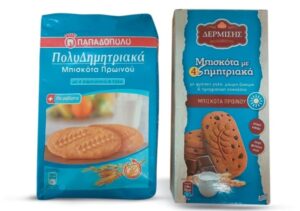The Greek Supreme Court has recently handed down its ruling in a cassation appeal concerning the shape of biscuits and their protection as unregistered trademarks (no 659/2023), confirming the findings of the Athens Court of Appeal. The biscuits, although quite well-known, were considered non-distinctive, as was the image of two spikes of wheat embossed on the surface of the biscuit. The plaintiff’s attempt to stop sales of similar shaped biscuits with an embossed spike of wheat on top therefore failed.
The biscuit company Papadopoulou, which is quite famous in Greece, has been marketing since 1997 multi grain biscuits in four types and four different packages:

Papadopoulou brought a lawsuit against the defendant Greek company Dermisis which started commercializing multi grain biscuits in packages as shown below in 2016:


Papadopoulou argued that it had been selling its biscuits for 20 years, had sold more than 10 million biscuits in Greece in the years 2013-2017 alone, and had a market volume share of 3-4% and a value share of 6-7%. The annual advertising expenses 2011-2017 had been around 700,000 (in 2011) to 200,000 euros (in 2017). The biscuits always had the same specific oval shape and proportions and bore a three-dimensional depiction of two parallel spikes of wheat. These characteristics were entirely replicated by the defendant’s biscuits except that those bore one, not two, embossed spikes of wheat.
The law suit was dismissed and so was the appeal to the Athens Court of Appeal. The Court denied that the shape of the biscuits was worthy of protection as a designation of origin, namely as an unregistered trademark and source identifier under Greek unfair competition law.
The Court in its obiter dicta reiterated that the shape and get up of a product may have distinctive character and therefore be protected as an unregistered trademark, if different to the product itself and chosen arbitrarily, without serving a functional role, namely if it not technically necessary to fulfill the purpose of the product. If the characteristics are chosen arbitrarily even if at the same time contribute to and assist the functional purpose of the product, they can be protected.
However, it held that the shape of Papadopoulou’s biscuits did not have the minimum degree of originality, so as to be able to function as a source identifier, based on the evidence before it that the oval shape was the most functional and practical one for plain biscuits without filling. Α survey was also produced by the plaintiff that showed that 41% of the public recognised the biscuits as emanating from it. This was considered to be only a “small” part of consumers and therefore insufficient for proving acquired distinctiveness. The Court reiterated that the lower the inherent distinctiveness the more intense the use of a sign needs to be. In a somewhat contradictory finding, the Court stated that the shape of the biscuits was known to the consumers but not sufficiently to work as source indicator. The market share was deemed small. Consequently, the Court of Appeal found that since there were no unregistered trademark rights, there was no need to examine any risk of confusion. The Court also found that the defendant did not take any advantage of the reputation of the shape of Papadopoulou’s biscuits.
Upon Papadopoulou’s cassation appeal, the Supreme Court upheld the Court of Appeal’s judgment. Many of that court’s findings were of a factual nature and therefore not reviewed. This included the finding that the shapes at hand and the designs on them were not distinctive. The shapes were the most functional and practical for biscuits of this category, and the designs on them were commonplace and descriptive of the grains included in the biscuits. Also the finding that only a small part of the consumers would consider the biscuits to be a source indicator was of a factual nature. As a result, lack of distinctiveness was confirmed, as well as the Court of Appeal’s conclusion that likelihood of confusion or harm to the reputation did not need to be further considered. As a result and given that the plaintiff did not invoke similarity of the packaging, apparently because of the different packages for the whole range of biscuits, the following two packages of the two parties are allowed to co-exist in the Greek market:

_____________________________
To make sure you do not miss out on regular updates from the Kluwer Trademark Blog, please subscribe here.
Kluwer IP Law
The 2022 Future Ready Lawyer survey showed that 79% of lawyers think that the importance of legal technology will increase for next year. With Kluwer IP Law you can navigate the increasingly global practice of IP law with specialized, local and cross-border information and tools from every preferred location. Are you, as an IP professional, ready for the future?
Learn how Kluwer IP Law can support you.


